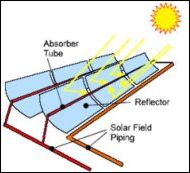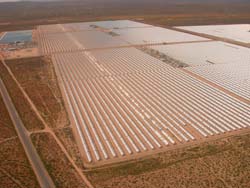| 27 May 2008 | ||||||||||||||||||||||||||||||||||||||||||||
Google, Goldman Sachs and oil firm Chevron believe that earth's future energy needs lie in the sun, and are willing to invest millions in that belief By Sourya Biswas What does the largest search engine in the virtual world and the largest investment bank in the real world have in common, besides each being worth billion of dollars - in real money that is? Well, for one, Google and Goldman Sachs both believe that earth's future energy needs lie in the sun, and are willing to invest millions in that belief. And for good measure, they are joined by one of the biggest oil companies, Chevron, as well.
Solar thermal collectors are characterised by the US Energy Information Agency as low, medium, or high temperature collectors. Low temperature collectors are flat plates generally used to heat swimming pools. Medium-temperature collectors are also usually flat plates but are used for creating hot water for residential and commercial use. High temperature collectors concentrate sunlight using mirrors or lenses and are generally used for electric power production. However, we are concerned here only with the high temperature collectors, which some opine, can satisfy as much as 50 per cent of America's energy needs by 2020. Moreover, they feel that the cost of the technology, presently higher than coal, oil and gas, may soon fall below those of conventional energy sources. Considering the rapid rise that oil has seen in recent weeks, such beliefs are not entirely unjustified. One of the biggest believers in this technology, and one of the earliest to put money in, is Indian-born venture capitalist Vinod Khosla. He has been one of the co-founders of Sun Microsystems and became a general partner of the venture capital firm Kleiner, Perkins, Caufield & Byers in 1986, after which he formed his own firm Khosla Ventures in 2004. Using his association with these firms he has invested heavily in renewable and new energy sources like ethanol and solar energy. In September 2007, Khosla led a $40-million investment in solar power producer Ausra Inc. with Kleiner, Perkins, Caufield & Byers. Ausra's proprietary technology significantly reduces the cost of a solar thermal power plant and so is capable of significantly reducing global carbon emissions normally associated with electricity generation. In December 2007 it announced it was building the first US manufacturing plant for solar thermal power systems, in Las Vegas. The 130,000-square-foot, highly automated manufacturing and distribution centre will produce the reflectors, towers, absorber tubes, and other key components of the company's solar thermal power plants Ausra's plants will produce electricity at 10 cents a kilowatt-hour starting in 2010, and the price will fall to 8 cents a few years later as it adopts systems with fewer parts that will be less costly when widely deployed, the company says. ''We are going to beat coal,'' says Bob Fishman, Ausra's CEO. A solar thermal unit that begins operation in 2010 will produce power at 14.2 cents a kilowatt hour, almost three times the 4.8 cents for a plant using pulverized coal, the US Energy Information Administration estimates. Both Chevron and Google have invested in solar energy startup BrightSource Energy Inc. Other investors in this company include JP Morgan and Morgan Stanley. In March 2008, BrightSource entered into a series of power purchase agreements with PG&E for up to 900MW of electricity. BrightSource is currently developing a number of solar power plants in the Mojave Desert of Southern California, with construction of the first plant planned to start in 2009. Goldman Sachs is seeking land to lease as demand out-paces wind turbines and geothermal, the other competitors to solar energy for top position in the renewable energy stakes. Others have filed more than 50 applications with the US Bureau of Land Management to lease government-owned desert property for solar power systems. Another big name in solar thermal power is Florida Power & Light Company, the principal subsidiary of FPL Group, Inc. commonly referred to by its initials, FPL. Although a conventional electricity producer and distributor in over 20 American states, it too has invested heavily in solar thermal technology and is the main owner of the SEGS solar power plants, the largest array in the world.
The installation uses parabolic trough solar thermal technology along with natural gas to generate electricity. The plants have a 354 MW installed capacity, making it the largest installation of solar plants of any kind in the world. By comparison, the largest photovoltaic plant, which is in Spain, produces 20 MW, although a 40 MW PV installation (Waldpolenz Solar Park) is under construction in Germany and a 154 MW PV Solar power station in Victoria, Australia, is planned. The SEGS power plants were commissioned between 1984 and 1991. The facilities have a total of over 1,000,000 mirrors and cover more than 1,600 acres (6.4 square-km). SEGS VIII (80 MW) and SEGS IX (80 MW) are the largest solar power plants individually and collectively in the world. The parabolic reflectors have an efficiency of more than 90 per cent, compared with 80 per cent for a typical bathroom mirror. That means a reflector reflects 90 per cent of the sunlight that falls on it while absorbing the rest. FPL uses 15,000-litre trucks to spray water weekly to clean the surfaces, seven feet off the ground. ''There's always been a solar resource here,'' says Harvey Stephens, a production manager and one of 100 workers at the plant. ''It's just that it hasn't been cost-effective enough.'' However, all that may soon change. Costs for solar thermal may fall as low as 3.5 cents a kilowatt-hour by 2020, according to a report commissioned by the US Energy Department. Meanwhile, coal expenses may rise. Moreover, there are other costs to producing electricity using coal, pollution for instance. The US Congress is considering limits on carbon dioxide and other greenhouse gas emissions. The purchase of pollution permits may be required under a measure the US Senate will begin debating next month. However, solar thermal power suffers from one very obvious drawback - its complete dependence on sunlight. If the skies are cloudy, no electricity can be produced. Solar thermal companies are trying to develop backup heat storage using pressurized boiling water or molten salt that can be warmed to more than 1,000 degrees. Solar power ''fits with our peak demand very well as long as the sun is cooperating, ''says Michael Yackira, CEO of Sierra Pacific Resources, the company that owns utilities serving Las Vegas and other Nevada cities. ''When it's cloudy, when it's raining, when it's dark, it doesn't produce power.'' However, even with this drawback, the future of solar thermal power is ''bright'', pun intended. And many more investments can be expected in this ''sunshine'' sector, pun intended again. | ||||||||||||||||||||||||||||||||||||||||||||
Tuesday, May 27, 2008
Energy of the future - solar thermal power!
Subscribe to:
Post Comments (Atom)
Blog Archive
-
▼
2008
(81)
-
▼
May
(11)
- Energy of the future - solar thermal power!
- Some interesting facts about solar thermal power news
- Solar Energy Commission proposed
- Big players line up for solar projects in Haryana
- DOE Marks $60 M for Solar Thermal Funding
- On the Rise: Solar Thermal Power and the Fight Aga...
- U.S. DOE putting up $60M for solar thermal
- Bright Source’s Power Tower
- Solar without the Panels
- Is Desert Solar Power the Solution to Europe's Ene...
- SkyFuel secures $17m to commercialise solar trough
-
▼
May
(11)
 All these big names have poured in big money in companies that specialise in solar thermal technology. This technology is a lot simpler technically than the more popular solar photovoltaic cells that convert sunlight directly to electricity. Here, sunlight is focused with mirrors to heat oil in glass pipes to about 370 degrees Celsius, which is used to turn water to steam. The steam spins an electric turbine to generate electricity by electromagnetic induction.
All these big names have poured in big money in companies that specialise in solar thermal technology. This technology is a lot simpler technically than the more popular solar photovoltaic cells that convert sunlight directly to electricity. Here, sunlight is focused with mirrors to heat oil in glass pipes to about 370 degrees Celsius, which is used to turn water to steam. The steam spins an electric turbine to generate electricity by electromagnetic induction. Solar Energy Generating Systems (SEGS) is the name given to nine solar power plants in California's Mojave Desert, where sunlight is among the best available in the United States. SEGS III, VII are located at Kramer Junction, with SEGS VIII, IX at Harper Lake and SEGS I, II at Daggett respectively.
Solar Energy Generating Systems (SEGS) is the name given to nine solar power plants in California's Mojave Desert, where sunlight is among the best available in the United States. SEGS III, VII are located at Kramer Junction, with SEGS VIII, IX at Harper Lake and SEGS I, II at Daggett respectively.
No comments:
Post a Comment